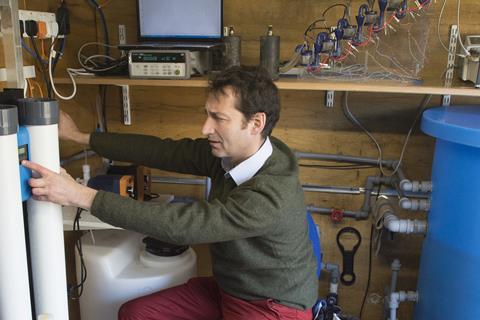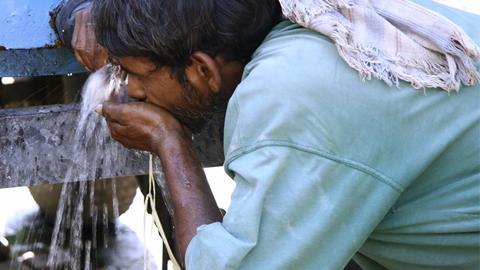Hayley Bennett investigates water treatment technologies that are saving lives where there are no taps or pipes
One warm afternoon, I find myself picking a path around a pond. I’m on my way to view a shed, but, partly masked by leafy foliage on one side and tall grass on the other, the dull green hut is not obvious to passing foot traffic. And there’s a lot of that, because we’re on campus at the University of the West of England, just outside Bristol.
I’m following Darren Reynolds, a professor in the applied sciences department. As he unlocks the door, it becomes clear this is not a shed for storing garden tools in, or potting plants. Inside, every available wall space is covered in pipes, sockets, unidentifiable electronic devices and meters.
‘[It’s] essentially a Tardis,’ Darren had joked earlier in the day. As he starts flicking switches with the casual dexterity of a time lord, low-level, mechanical noise starts. The shed whirrs into action and I prepare myself for a ride into space-time. The most obvious clues to the shed’s actual purpose are the sound of running water and two tall, blue plastic containers. A quick peak under the lid of one container reveals tens of gallons of murky pond water. But the other contains water that looks clean enough to drink, with more pouring into it from a spout.
The shed’s true function reveals itself. Very simply, it turns dirty water into clean water.
Download the text of this article (MS Word or pdf), all the teaching ideas as a single file (MS Word or pdf), or all the downloads in one zip file (MS Word or pdf)
Download the text of this article, and all the related teaching resources, worksheets and experiments from the Education in Chemistry website: rsc.li/EiCpw
The study of water is important in many disciplines, including biology, chemistry, geography and engineering. The supply of fresh water is fundamental to civilisation and is often threatened by natural disasters. Droughts and floods regularly feature in the news. As such, the practicals and content of this article can be used for a wide-range of purposes.

Specification links
Download a list of specification points this article supports from the Education in Chemistrywebsite: rsc.li/EiCpw

Getting off-grid
Although it seemed as if Darren was performing a magic trick, his shed was only doing something that we in the developed world rely on every day just to stay alive. It’s like a miniature water-processing plant: receiving dirty water; filtering and chemically killing off the undesirables; and then piping it into a clean container where no one would believe it had not long arrived from a muddy pond.
The uses of small-scale water treatment like this may not be obvious on a university campus in the UK, where clean water comes out of a tap. But over two billion people in the world today have no easy access to safe drinking water. ‘We’re so ignorant to it because our daily lives are not impacted in that way, but it’s a massive problem and the solution isn’t building big treatment works,’ Darren tells me. ‘That kind of model isn’t going to work in developing countries. So my idea is that we have small, off-grid water supplies to relieve some of that pressure.’
It’s easy to forget that even though London was supplying water through wooden pipes in the 16th century, poorer residents were still taking their water from the river Thames into the 19th century. Today, there are 1433 centralised water treatment facilities and over 416,000 km of mains water pipes in the UK. Dirty water is collected in reservoirs where big particles settle to the bottom. It is then filtered, usually through sand, and eventually piped into our taps with chlorine added to kill harmful organisms like bacteria. Ion exchange resins can also be used to remove pollutants [pdf] that are dissolved in the water, including heavy metals such as mercury and cadmium.
Small-scale solutions
Darren’s system does a similar thing, but it fits on the back of a lorry, quite literally. His team has been driving it all over Europe carrying out trials, most recently in Romania and Greece. When I call him recently to ask how things are going, he tells me their manufacturing partner, Portsmouth Aviation, is now taking orders for the miniature water treatment units. His team describe the units as combining ultrafiltration and electrochemically activated solutions. Ultrafiltration is akin to a massively scaled-down version of what happens in centralised treatment facilities. After the dirty water is pumped into a settling tank – a sort of tiny reservoir – it is pumped through thin membranes with pores 5–100 nm wide. The holes are so small that over 99% of bacteria and viruses can’t get through them, so are removed from the water.
As well as this, the units employ a chemical treatment component; a ‘green biocide’ that wipes out disease-causing microbes with minimal environmental impact. The trouble with the chlorine used in centralised water treatment facilities is it’s so toxic it’s hazardous to store and transport in large quantities. Chlorine gas is well known for being used as a weapon in the first world war, as well as the Iraq war, and there have been many examples of poisonings due to accidental release from chemical plants and transport vehicles.
Experiment, ages 11–14 (science club) and 14–16 (class) and extension questions, ages 14–16
This standard microbiology practical lies at the interface of chemistry and biology. Place discs soaked in the halogen waters on bacterial lawns grown on agar plates. Compare the zones of inhibition at a suitable point (which depends on the bacteria used) to determine which halogen has the best antibacterial action. Encourage pupils to think about exactly what they need to record in order to give the best account of their experiment.
Extension questions are also provided that prompt learners to consider why particular halogens are chosen as antibacterials in different situations.
Download the teacher guide (MS Word or pdf), student handout (MS Word or pdf), extension questions (MS Word or pdf) and extension answers (MS Word or pdf).
Download the worksheet of six exam style questions for students and the answers sheet from the Education in Chemistrywebsite: rsc.li/EiCpw
The electrochemically activated solutions described by Darren’s team do still rely on the killing power of chlorine, but not in the same way or in such large quantities. Darren explains: ‘We’re not dealing in dissolved chlorine. Bleaches and stuff like that release chlorine over time, and they need to do that because they’re disinfecting within distribution systems. Our chlorine is very fast, very immediate and it doesn’t hang around, so it would not be very good for distribution.’
It is, however, good for quickly dealing with dirty pond water. The disinfectant is made on demand by the electrolysis of salty water in an electrochemical cell within the treatment unit. When an electric current is applied, the sodium and chlorine in the salt separate into their ions and collect on opposite sides of a membrane in the cell. The chlorine briefly joins up with hydrogen and oxygen in the electrolysed water to form hypochlorous acid, which can kill bacteria and other microorganisms in 10 seconds flat. After its job is done and the current is switched off, the chlorine turns back into salt in the water again. According to Darren, this method has ‘more bang for its buck’, using less chlorine than conventional disinfectants to give the same killing effect.
Class experiment, ages 14–16
In this experiment pupils work in pairs to construct a cell to carry out electrolysis. This improvised cell is easy to construct and very effective.
Download the teacher notes and student handout from the Education in Chemistry website: rsc.li/EiCpw
The concept of mobile, off-grid water treatment is not novel. In fact, India’s Central Salt & Marine Chemicals Research Institute (CSMCRI) in Bhavnagar, Gujarat, operates refitted buses housing water purification technologies developed at the institute.

The CSMCRI treatment units do not use chemical disinfectants, instead relying on advanced membranes made from thin-film composites – a combination of an ultrathin, ‘active’ barrier layer and a thicker layer with larger pores made from a different material. The ultrathin barrier excludes contaminants via nanoscale pores, while the thicker layer supports the whole structure.
The membranes are used in a process called reverse osmosis, which can remove salt and other contaminants from seawater. The 150–200 nm thick active layer is made either from polyureas or polyamides; the thinner the layer, the faster water can be processed. It is coated onto a thicker (35 μm) support layer by machine. The surface of the thinner layer can be chemically modified to help it resist ‘fouling’ – getting blocked by gunk in the water it is purifying. As it’s known that making the surface more hydrophilic (water-loving) stops stuff sticking to it, the researchers add hydroxyl and sulfonic acid groups to keep it working for longer.
Maths in science, ages 14–16
Pupils really struggle to imagine just how small measurements in nanometres actually are. These exercises immerse pupils in the mathematics of this measurement using familiar objects and a variety of pupil learning activities. They include a matching exercise, a reading exercise, a calculator conversion exercise and construction of a scale using toilet paper. The exercises are differentiated to give greater to support to pupils with lower prior achievement. These activities can be used as a single lesson focusing on maths in science.
Download the teacher guide (MS Word or pdf), foundation student handout (MS Word or pdf) and higher student handout (MS Word or pdf).
Download the teacher notes and student handout from the Education in Chemistry website: rsc.li/EiCpw
Disaster relief
One of the most immediate applications for Darren’s water-purifying systems is in disaster-stricken regions, where they could be dropped in by helicopter. ‘If you have an earthquake, or some other kind of catastrophe, then you have the ability to take a box, drop it down with a helicopter, stick a pipe in some body of water and then press a button to produce drinkable water,’ says Darren. His system can produce 18,000 litres of clean water an hour. Assuming the average person can live on five litres of water a day, one box running for an hour could supply 3600 people’s daily needs. Running 12 hours a day, the same box could theoretically supply 216,000 litres of water a day – enough for over 43,000 people.
Meanwhile, the CSMCRI’s modified buses are already helping people affected by flooding, drought and other catastrophes across India. Since the Asian tsunami in 2004, these water treatment units on wheels have proven themselves again and again, as one of the chief scientists at the institute, Nagendra Pathak, explains. ‘One of the first missions the mobile unit was deployed for was mitigation of acute drinking water problems in West Bengal in the aftermath of Cyclone Aila. The mobile unit has played a laudable role in providing water to the needy in the aftermath of natural calamities such as the super cyclone Phailin [in 2013], Asian tsunami and during severe drought in the Latur District of Marathwada.’
According to Nagendra, the current off-grid capacity of the mobile units is 1000–3000 litres per hour depending on the saltiness of the water it is processing. The system generates the energy to do this from the engine of the bus itself. In 2016, during the Latur drought, CSMCRI stationed its water-treatment bus at a well in the city centre, where it produced 40,000–50,000 litres of clean water per day. The previous year, a mobile unit was sent to Rishikesh, at the foot of the Himalayan mountains, to supply water to survivors of flash floods that hit the region.
Class experiment and particle pictures pair work, ages 11–14
Separating salt from rock salt is a common practical for younger secondary school pupils. Learn Chemistry has a guide to the practical.
Running it as a competition adds a nice challenge element. The winner has the cleanest salt sample.
Download the teacher notes and student handout from the Education in Chemistry website: rsc.li/EiCpw
Outbreaks of water-borne disease often follow natural disasters, so for those affected, the choice is too often either dying of thirst or getting sick from drinking dirty water and dying later. Off-grid water treatment deals with the biological contaminants responsible for these diseases. Nagendra says the system can also deal with chemical contaminants such as heavy metals.
Home luxuries
Back in Bristol, Darren’s team is now looking at adding nanofiltration to its system, which involves membranes with pore sizes just 1–5 nm. The addition would mean their system too could tackle seawater and brackish (slightly salty) water, as well as water containing inorganic pollutants, including agricultural wastes such as nitrates and phosphates.
Their trials in Europe, he says, highlighted how needed this is. ‘What we’ve found is some communities in Romania and Greece, they’re extracting from groundwater. These are [polluted] groundwaters, but they’re still using them anyway, and they’re using them to drink. So you’ve got nitrate issues, blue baby syndrome, that kind of thing.’ Blue baby syndrome is a condition thought to be related to nitrates in groundwater. Babies become breathless and look blue because they can’t get enough oxygen into their blood.
All of which serves as a stark reminder that when these units go into action, it could be in a life-and-death scenario anywhere in the world, devoid of the luxuries of pipes and taps. A far cry, for sure, from the peaceful surroundings at the shed, on a university campus, where access to clean water isn’t even a thought that occurs to many of us.
Downloads available for this article
- Full article, without resources or notes (MS Word or pdf)
- All teaching ideas in a single file (MS Word or pdf)
- All the downloads in one zip file (MS Word or pdf)
- Specification links (MS Word or pdf)
- Antibacterial halogens teacher guide (MS Word or pdf)
- Antibacterial halogens student handout (MS Word or pdf)
- Antibacterial halogens extension questions (MS Word or pdf)
- Antibacterial halogens extension answers (MS Word or pdf)
- Electrolysis teacher notes (MS Word or pdf)
- Electrolysis student handout (MS Word or pdf)
- Nanoscale maths teacher guide (MS Word or pdf)
- Nanoscale maths foundation handout (MS Word or pdf)
- Nanoscale maths higher handout (MS Word or pdf)
- Separating salt rock teacher notes (MS Word or pdf)
- Separating salt rock particle pictures (MS Word or pdf)
Hayley Bennett is a science writer based in Bristol, UK
Resources by Kristy Turner, a school teacher fellow at University of Manchester/Bolton School, UK
Downloads
Full article
Word, Size 58.38 kbFull article
PDF, Size 83.46 kbAll teaching ideas
Word, Size 0.18 mbAll teaching ideas
PDF, Size 0.18 mbAll downloads, MS Word zip file
Zip, Size 3.3 mbAll downloads, pdf zip file
Zip, Size 1.23 mbSpecification links
Word, Size 56.54 kbSpecification links
PDF, Size 52.74 kbAntibacterial halogens: experiment teacher guide
Word, Size 52.94 kbAntibacterial halogens: experiment teacher guide
PDF, Size 43.32 kbAntibacterial halogens: experiment student handout
Word, Size 52.99 kbAntibacterial halogens: experiment student handout
PDF, Size 43.29 kbAntibacterial halogens: extension questions
Word, Size 53.22 kbAntibacterial halogens: extension questions
PDF, Size 43.56 kbAntibacterial halogens: extension question answers
Word, Size 53.26 kbAntibacterial halogens: extension question answers
PDF, Size 43.58 kbElectrolysis improvised cell: teacher notes
Word, Size 0.1 mbElectrolysis improvised cell: teacher notes
PDF, Size 94.52 kbElectrolysis improvised cell: student handout
Word, Size 0.1 mbElectrolysis improvised cell: student handout
PDF, Size 86.54 kbNanoscale maths in science: teacher guide
Word, Size 56.98 kbNanoscale maths in science: teacher guide
PDF, Size 59.35 kbNanoscale maths in science: student handout foundation
Word, Size 58.78 kbNanoscale maths in science: student handout foundation
PDF, Size 61.59 kbNanoscale maths in science: student handout higher
Word, Size 57.47 kbNanoscale maths in science: student handout higher
PDF, Size 60.36 kbSeparating salt rock: teacher notes
Word, Size 0.13 mbSeparating salt rock: teacher notes
PDF, Size 0.12 mbSeparating salt rock: particle picture templates
Word, Size 3.3 mbSeparating salt rock: particle picture templates
PDF, Size 0.13 mb
















No comments yet